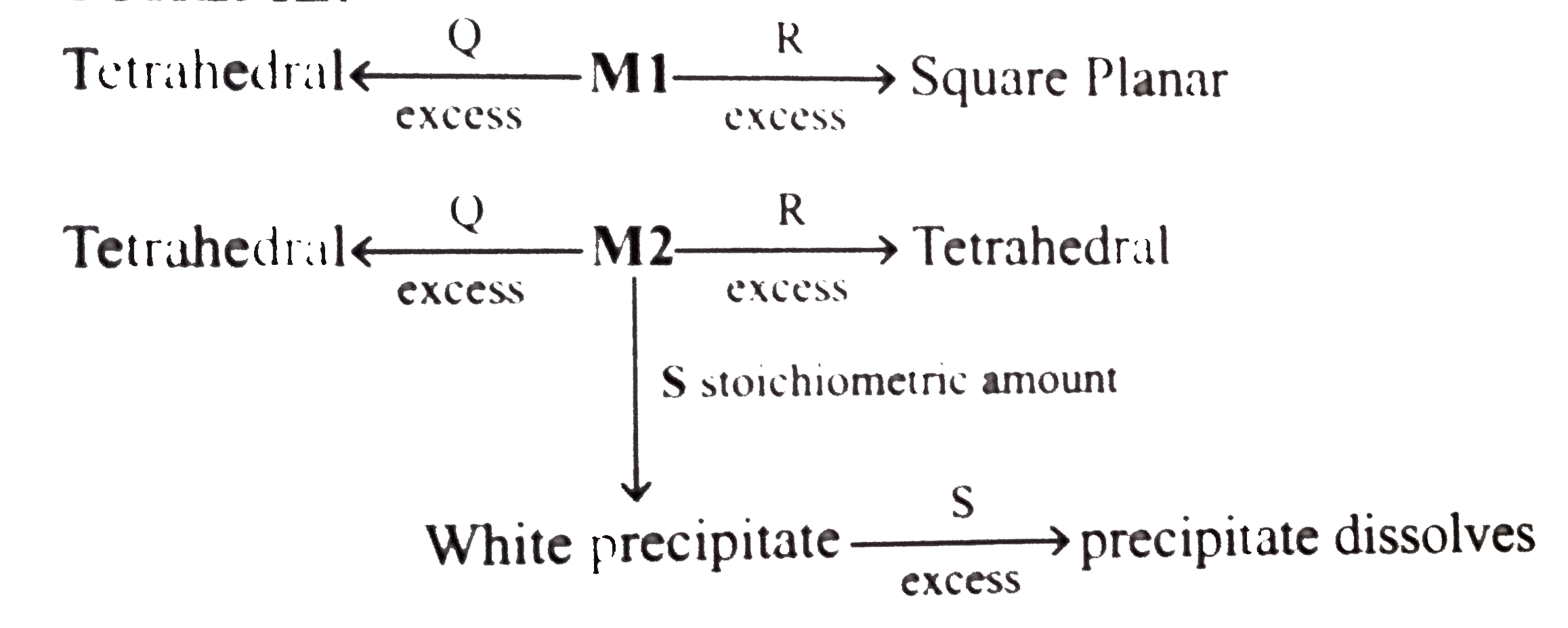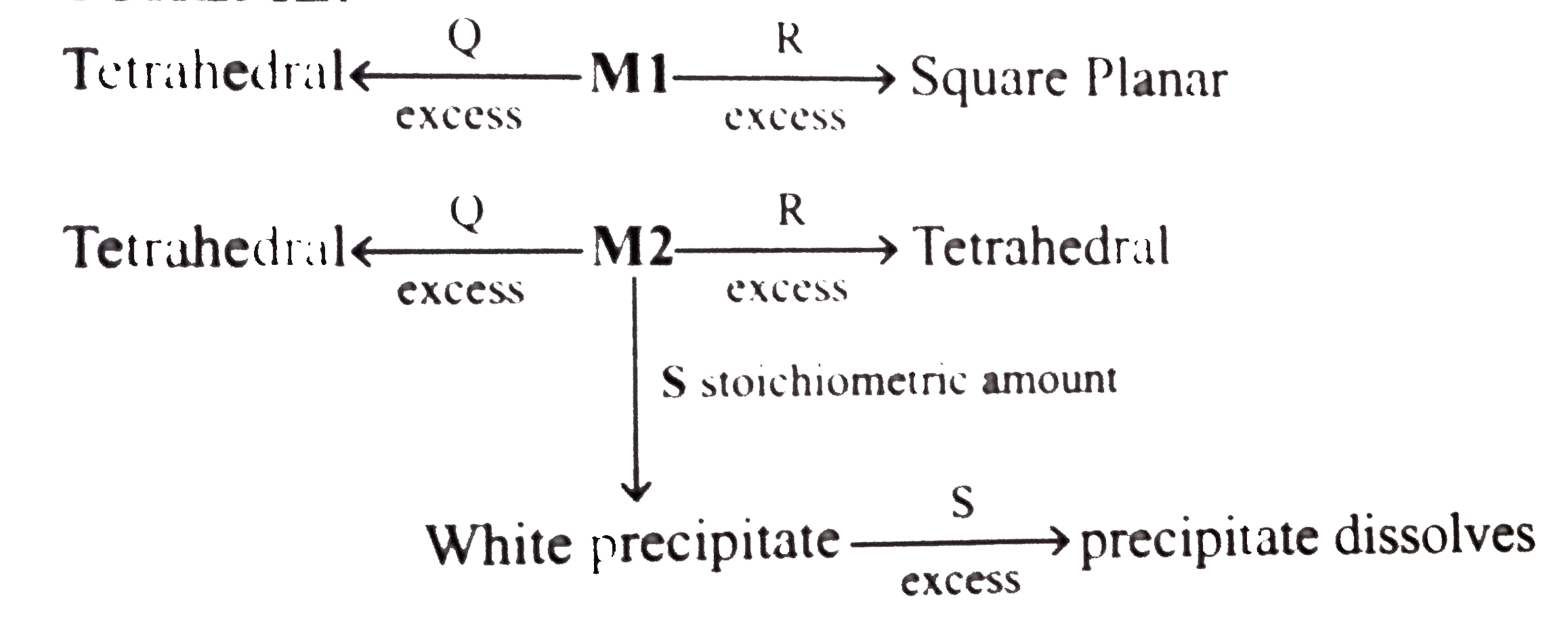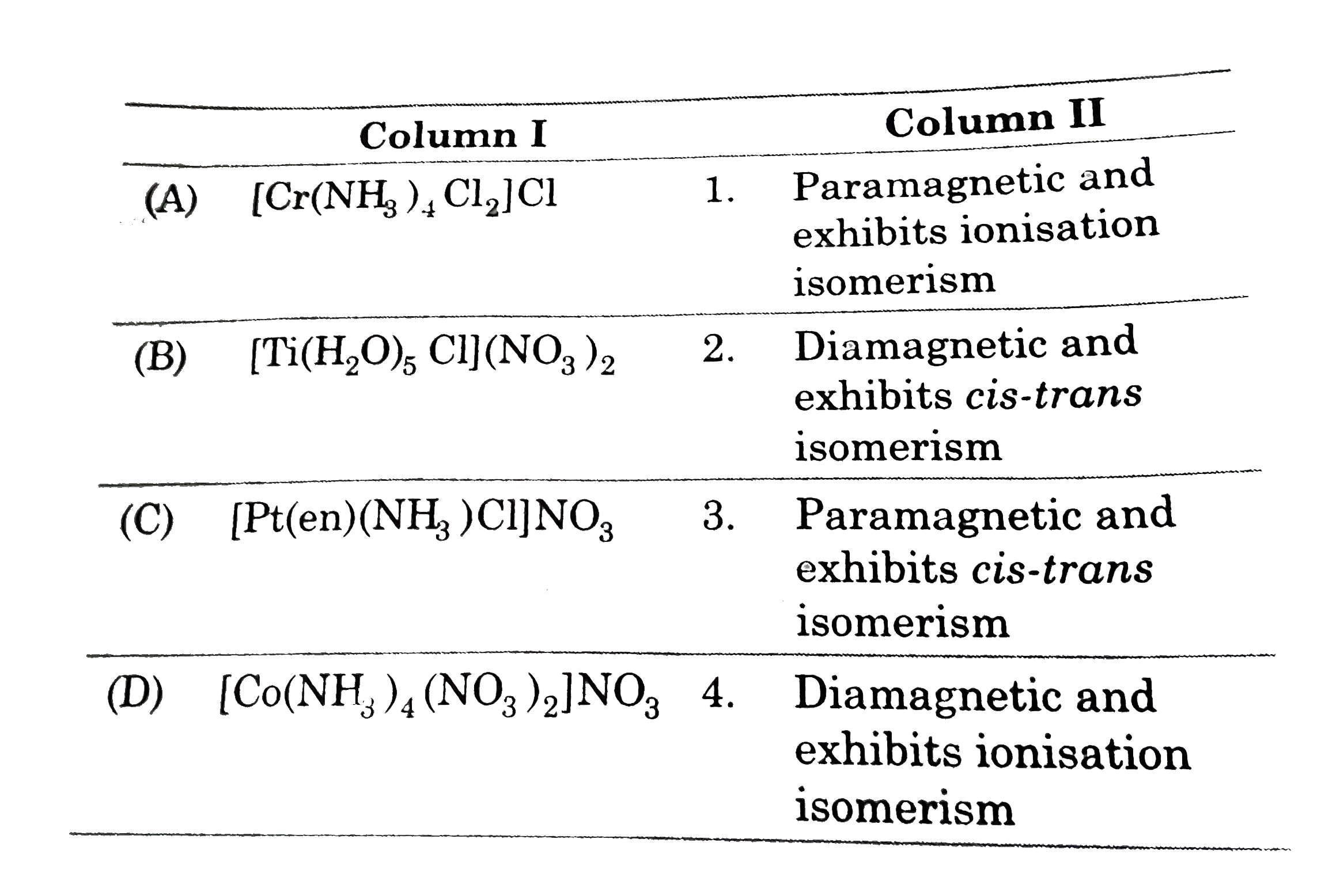JEE SECTION MORE THAN ONE CHOICE CORRECT ANSWER from UNIVERSAL BOOK DEPOT 1960 CHEMISTRY (HINGLISH) COORDINATION CHEMISTRY for Class 12
| Class 12 | CHEMISTRY |
| Chapter | COORDINATION CHEMISTRY |
| UNIVERSAL BOOK DEPOT 1960 CHEMISTRY (HINGLISH) | JEE SECTION MORE THAN ONE CHOICE CORRECT ANSWER |
| Medium | English |
| Academic Year | 2023-2024 |
Question 56
Consider the following reaction and statements:
[Co(NH3)4Br2]++Br−→[Co(NH3)3Br3]+NH3
Two isomers are produced if the reactant complex ion is a cis-isomer
Two isomers are produced if the reactant complex ion is a trans-isomer
Only one isomer is produced if the reactant complex ion is a trans-isomer
Only one isomer is produced if the reactant complex ion is a cis – isomer
The correct statements areView SolutionQuestion 63
Addition of excess aqueous ammonia to a pink coloured aqueous solution of MCl2.6H2O(X)andNH4Cl gives an octahedral complex Y in the presence of air. In aqueous solution, complex Y behaves as 1:3 electrolyte. The reaction of X with excess HCl at room temperature results in the formation of a blue coloured complex Z. The calculated spin only magnetic moment of X and Z is 3.87 B.M., whereas it is zero for complex Y.
Among the following options, which statement is incorrect ?View SolutionQuestion 71
(a). Assertion (A) is true, Reason (R) is also true, Reason (R) is the correct explanation for assertion (A).
(b). Assertion (A) is true, Reason (R) is true, Reason (R) is not the correct explanation for Assertion (A).
(c). Assertion (A) is true, Reason (R) is false.
(d). Assertion (A) is false, Reason (R) is true.
Q. Assertion (A): to a solution of potassium chromate, if a strong acid is added, it changes its colour from yellow to orange.
Reason (R): The colour change is due to the change in oxidation state of potassium chromate.View SolutionQuestion 75
STATEMENT-1: In complex [Cr(NH3)4BrCl]Cl, the'spin only' magnetic moment is close to 1.73 B.M.
STATEMENT-2: All known monoculear complexeas of chromim (III) irrespective of the strength of the ligand field, must hae three unpaired electrons.
Consider the following statement and arrange in the order of trur/flase as given in the codes.View SolutionQuestion 81
When a metal rod M is dipped into an aqueous colourless concentrated solution of compound N, the solution turns light blue. Addition of aqueous NaCl to the blue solution gives a white precipitate O. Addition of aqueous NH3 dissolves O and gives an intense blue solution.
The metal rod M is View SolutionQuestion 82
When a metal rod M is dipped into an aqueous colourless concentrated solution of compound N, the solution turns light blue. Addition of aqueous NaCl to the blue solution gives a white precipitate O. Addition of aqueous NH3 dissolves O and gives an intense blue solution.
The compound N is View SolutionQuestion 83
When a metal rod M is dipped into an aqueous colourless concetrated solution of compound N, the solution turns light blue. Addition of aqueous NaCl to the blue solution gives a white precipitate O. Addition of aqueous NH3 dissolves O and gives an intense blue solution.
Q. The final solution contains. View SolutionQuestion 84
An aqueous solution of metal ion MI reacts separately with reagents Q and R in excess to give tetrahedral and square planar complexes, respectively An aqueous solution of another metal ion M2 always forms tetrahedral complexs with theses reagents. Aqueous solution of M2 on reaction with reagent S gives white precipitate which dissolves in excess of S The reactions are summarised in the scheme given below: SCHEME :

what is M1,Q and RView SolutionQuestion 85
An aqueous solution of metal ion MI reacts separately with reagents Q and R in excess to give tetrahedral and square planar complexes, respectively An aqueous solution of another metal ion M2 always forms tetrahedral complexs with theses reagents. Aqueous solution of M2 on reaction with reagent S gives white precipitate which dissolves in excess of S The reactions are summarised in the scheme given below: SCHEME :

what is M2 and S??View SolutionQuestion 86
Double salts are addition compounds which lose their identify in aqueous solution whereas complexes which are also addition compounds do not lose their identify in aqueous solution. The coordination compounds show isomerism and find application in photography , qualitative analysis, metallurgy, water purification and in the treatment of various diseases.
Which of the following statement is incorrect ?View SolutionQuestion 87
Double salts are addition compounds which lose their identity in aqueous solution whereas complexes which are also addition compounds do not lose their identity in aqeous solution. The coordination compounds show isomerism and find applications in photography , qualitative analysis, metallurgy , water purification and in the treatment of various diseases.
Which of the following statements is true for the complex, [Co(NH3)4Br2]NO2View SolutionQuestion 88
Double salts are addition compounds which lose their identity in aqueous solution whereas complexes which are also addition compounds do not lose their identity in aqeous solution. The coordination compounds show isomerism and find applications in photography , qualitative analysis, metallurgy , water purification and in the treatment of various diseases.
Choose the correct option for the complex [PtCl2(en)2]2+View SolutionQuestion 99
Match the entries listed in Column I with appropriate entries listed in Column II
AK3[Fe(CN)5(CO)]pComplex having lowest bond length of CO ligandBK[PtCl3(C2H4)]qFollow rule of EANCNa[Co(CO)4]rComplex involvedin synergic bondingDV(CO)6sComplex having highest bond length of Co ligandView SolutionQuestion 100
The ammonia prepared by treating ammonium sulphate with calcium hydroxide is completely used by NiCl2.6H2O to form a stable coordination compound. Assume that both the reactions are 100% complete. If 1584 g of ammonium sulphate and 952 g of NiCl2.6H2O are used in the preparation, the combined weight (in grams) of gypsum and the nickel- ammonia coordination compound thus produced is ____.
(Atomic weights in gmol−1 : H = 1, N = 14, O = 16, S = 32, Cl = 35.5, Ca = 40, Ni = 59) View Solution
All Exercises from UNIVERSAL BOOK DEPOT 1960 CHEMISTRY (HINGLISH) Class 12 CHEMISTRY COORDINATION CHEMISTRY
- ORDINARY THINKING OBJECTIVE QUESTIONS (APPLICATION OF ORGANOMETALLICS)
- ORDINARY THINKING OBJECTIVE QUESTIONS (BASIC TERMS)
- ORDINARY THINKING OBJECTIVE QUESTIONS (COMPLEXES AND COMPLEX STABILITY)
- ORDINARY THINKING OBJECTIVE QUESTIONS (HYBRIDISATION AND GEOMETRY)
- ORDINARY THINKING OBJECTIVE QUESTIONS (ISOMERISM AND MAGNETIC PROPERTIES)
- ORDINARY THINKING OBJECTIVE QUESTIONS (NOMENCLATURE, OXIDATION STATE AND EAN NUMBER)
- CRITICAL THINKING OBJECTIVE QUESTIONS
- JEE SECTION INTEGER TYPE QUESTIONS
- JEE SECTION MATRIX MATCH TYPE QUESTIONS
- JEE SECTION MORE THAN ONE CHOICE CORRECT ANSWER
- JEE SECTION REASONING TYPE QUESTIONS
- JEE SECTION COMPREHENSION TYPE QUESTION (PASSAGE - I )
- JEE SECTION COMPREHENSION TYPE QUESTION (PASSAGE - II)
- JEE SECTION COMPREHENSION TYPE QUESTION (PASSAGE - III)
- JEE SECTION ONLY ONE CHOICE ANSWER
- JEE(ADVANCED 2018 MORE THAN ONE CHOICE CORRECT ANSWER
- JEE(ADVANCED 2018 (NUMERIC ANSWER TYPE QUESTION )
